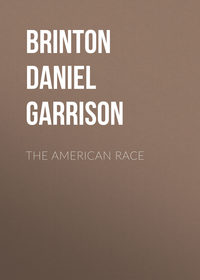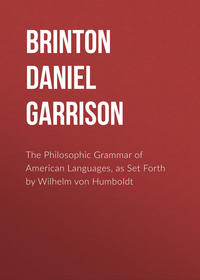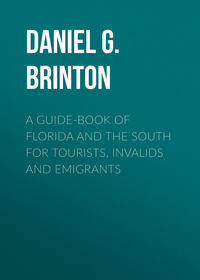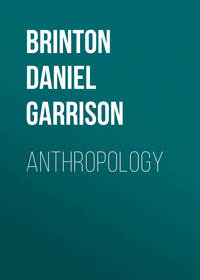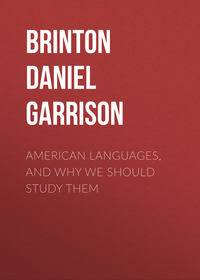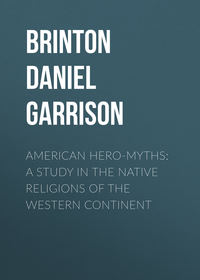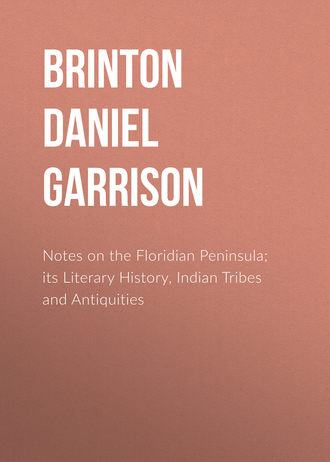 полная версия
полная версияNotes on the Floridian Peninsula; its Literary History, Indian Tribes and Antiquities

Daniel G. Brinton
Notes on the Floridian Peninsula; its Literary History, Indian Tribes and Antiquities
PREFACE
The present little work is the partial result of odd hours spent in the study of the history, especially the ancient history—if by this term I may be allowed to mean all that pertains to the aborigines and first settlers—of the peninsula of Florida. In some instances, personal observations during a visit thither, undertaken for the purposes of health in the winter of 1856-57, have furnished original matter, and served to explain, modify, or confirm the statements of previous writers.
Aware of the isolated interest ever attached to merely local history, I have endeavored, as far as possible, by pointing out various analogies, and connecting detached facts, to impress upon it a character of general value to the archæologist and historian. Should the attempt have been successful, and should the book aid as an incentive to the rapidly increasing attention devoted to subjects of this nature, I shall feel myself amply repaid for the hours of toil, which have also ever been hours of pleasure, spent in its preparation.
Thornbury, Penna., April, 1859.CHAPTER I.
LITERARY HISTORY
Introductory Remarks.—The Early Explorations.—The French Colonies.—The first Spanish Supremacy.—The English Supremacy.—The second Spanish Supremacy.—The Supremacy of the United States.—Maps and Charts.
In the study of special and local history, the inquirer finds his most laborious task is to learn how much his predecessors have achieved. It is principally to obviate this difficulty in so far as it relates to a very interesting, because first settled portion of our country, that I present the following treatise on the bibliographical history of East Florida. A few words are necessary to define its limits, and to explain the method chosen in collocating works.
In reference to the latter, the simple and natural plan of grouping into one section all works of whatever date, illustrating any one period, suggests itself as well adapted to the strongly marked history of Florida, however objectionable it might be in other cases. These periods are six in number, and consequently into six sections a bibliography naturally falls. The deeds of the early explorers, the settlement and subsequent destruction of the French, the two periods when Spain wielded the sovereign power, the intervening supremacy of England, and lastly, since it became attached to the United States, offer distinct fields of research, and are illustrated by different types of books. Such an arrangement differs not materially from a chronological adnumeration, and has many advantages of its own.
Greater difficulty has been experienced in fixing the proper limits of such an essay. East Florida itself has no defined boundaries. I have followed those laid down by the English in the Definitive Treaty of Peace of the 10th of February, 1763, when for the first time, East and West Florida were politically distinguished. The line of demarcation is here stated as “the Apalachicola or Chataouche river.” The Spaniards afterwards included all that region lying east of the Rio Perdido. I am aware that the bibliography of the Spanish settlement is incomplete, unless the many documents relating to Pensacola are included, but at present, this is not attempted. It has been deemed advisable to embrace not only those works specially devoted to this region, but also all others containing original matter appertaining thereto. Essays and reviews are mentioned only when of unusual excellence; and a number of exclusively political pamphlets of recent date have been designedly omitted.
As I have been obliged to confine my researches to the libraries of this country, it will be readily understood that a complete list can hardly be expected. Yet I do not think that many others of importance exist in Europe, even in manuscript; or if so, they have escaped the scrutiny of the laborious Gustav Haenel, whose Catalogi Librorum Manuscriptorum I have examined with special reference to this subject. It is proper to add that the critical remarks are founded on personal examination in all cases, except where the contrary is specified.
§ 1.—The Early Explorations. 1512-1562
No distinct account remains of the two voyages (1512, 1521,) of the first discoverer and namer of Florida, Juan Ponce de Leon. What few particulars we have concerning them are included in the general histories of Herrera, Gomara, Peter Martyr, and of lesser writers. However much the historian may regret this, it has had one advantage,—the romantic shadowing that hung over his aims and aspirations is undisturbed, and has given them as peculiar property to the poet and the novelist.
Of Pamphilo de Narvaez, on the contrary, a much inferior man, we have far more satisfactory relations. His Proclamation to the Indians1 has been justly styled a curious monument of the spirit of the times. It was occasioned by a merciful(!) provision of the laws of the Indies forbidding war to be waged against the natives before they had been formally summoned to recognize the authority of the Pope and His Most Catholic Majesty. Should, however, the barbarians be so contumacious as to prefer their ancestral religion to that of their invaders, or their own chief to the Spanish king, then, says Narvaez, “With the aid of God and my own sword I shall march upon you; with all means and from all sides I shall war against you; I shall compel you to obey the Holy Church and his Majesty; I shall seize you, your wives and your children; I shall enslave you, shall sell you, or otherwise dispose of you as His Majesty may see fit; your property shall I take, and destroy, and every possible harm shall I work you as refractory subjects.” Thus did cruelty and avarice stalk abroad in the garb of religion, and an insatiable rapacity shield itself by the precepts of Christianity.
Among the officers appointed by the king to look after the royal interest in this expedition, holding the post of comptroller or factor (Tesorero), was a certain Alvar Nuñez, of the distinguished family of Cabeza de Vaca or the Cow’s Head; deriving their origin and unsonorous name from Martin Alhaja, a mountaineer of Castro Ferral, who, placing the bones of a cow’s head as a landmark, was instrumental in gaining for the Christians the decisive battle of Las Navas de Tolosa (1212), and was ennobled in consequence. When war, disease, and famine had reduced the force of Narvaez from three hundred to only half a dozen men, Alvar Nuñez was one of these, and after seven years wandering, replete with the wildest adventure, returned to Spain, there to receive the government of a fleet and the appointment of Adelantado to the unexplored regions around the Rio de la Plata. Years afterwards, when his rapacity and reckless tyranny had excited a mutiny among his soldiers and the animosity of his associates, or, as his defenders maintain, his success their envy and ill-will, he was arraigned before the council of the Indies in Spain. While the suit was pending, as a stroke of policy in order to exculpate his former life and set forth to the world his steadfast devotion to the interests of the king, in conjunction with his secretary Pedro Fernandez he wrote and published two works, one under his own supervision detailing his adventures in Florida,2 the other his transactions in South America. Twenty-seven years had elapsed since the expedition of Narvaez, and probably of the few that escaped, he alone survived. When we consider this, and the end for which the book was written, what wonder that we find Alvar Nuñez always giving the best advice which Narvaez never follows, and always at hand though other men fail; nor, if we bear in mind the credulous spirit of the age and nation, is it marvellous that the astute statesman relates wondrous miracles, even to healing the sick and raising the dead, that he performed, proving that it was, as he himself says, “the visible hand of God” that protected him in his perilous roamings. Thus it happens that his work is “disfigured by bold exaggerations and the wildest fictions,” tasking even Spanish credulity to such an extent that Barcia prefaced his edition of it with an Examen Apologetico by the erudite Marquis of Sorito, who, marshalling together all miraculous deeds recorded, proves conclusively that Alvar Nuñez tells the truth as certainly as many venerable abbots and fathers of the Church. However much this detracts from its trustworthiness, it is invaluable for its ethnographical data, and as the only extant history of the expedition, the greatest miracle of all still remaining, that half a dozen unprotected men, ignorant of the languages of the natives and of their proper course, should have safely journeyed three thousand miles, from the bay of Apalache to Sonora in Mexico, through barbarous hordes continually engaged in internecine war. Of the many eventful lives that crowd the stormy opening of American history, I know of none more fraught with peril of every sort, none whose story is more absorbing, than that of Cabeza de Vaca.
The unfortunate termination of Narvaez’s undertaking had settled nothing. Tales of the fabulous wealth of Florida still found credence in Spain; and it was reserved for Hernando de Soto to disprove them at the cost of his life and fortune. There are extant five original documents pertaining to his expedition.
First of these in point of time is his commission from the emperor Charles V.3
The next is a letter written by himself to the Municipality of Santiago,4 dated July 9, 1539, describing his voyage and disembarkation. Besides its historical value, which is considerable as fixing definitely the time and manner of his landing, it has additional interest as the only known letter of De Soto; short as it is, it reveals much of the true character of the man. The hopes that glowed in his breast amid the glittering throng on the quay of San Lucar de Barrameda are as bright as ever: “Glory be to God,” he exclaims, “every thing occurs according to His will; He seems to take an especial care of our expedition, which lives in Him alone, and Him I thank a thousand times.” The accounts from the interior were in the highest degree encouraging: “So many things do they tell me of its size and importance,” he says, speaking of the village of Ocala, “that I dare not repeat them.” Blissful ignorance of the old cavalier, over which coming misfortune cast no presageful shadow!
The position that Alvar Nuñez occupied under Narvaez was filled in this expedition by Luis Hernandez de Biedma, and like Nuñez, he was lucky enough to be among the few survivors. In 1544, shortly after his return, he presented the king a brief account of his adventures.5 He dwells on no particulars, succinctly and intelligibly mentions their course and the principal provinces through which they passed, and throws in occasional notices of the natives. The whole has an air of honest truth, differs but little from the gentleman of Elvas except in omission, and where there is disagreement, Biedma is often more probable.
When the enthusiasm for the expedition was at its height, and the flower of Spanish chivalry was hieing to the little port of San Lucar of Barrameda, many Portuguese of good estate sought to enroll themselves beneath its banners. Among these, eight hidalgos sallied forth from the warlike little town of Elvas (Evora) in the province of Alemtejo. Fourteen years after the disastrous close of the undertaking, one of their number published anonymously in his native tongue the first printed account of it.6 Now which it was will probably ever remain an enigma. Because Alvaro Fernandes is mentioned last, he has been supposed the author,7 but unfortunately for this hypothesis, Alvaro was killed in Apalache.8 So likewise we have notices of the deaths of Andres de Vasconcelo and Men Roiz Pereira (Men Rodriguez); it is not likely to have been Juan Cordes from the very brief account of the march of Juan de Añasco, whom this hidalgo accompanied; so it lies between Fernando and Estevan Pegado, Benedict Fernandez, and Antonio Martinez Segurado. I find very slight reasons for ascribing it to either of these in preference, though the least can be objected to the latter. Owing to this uncertainty, it is usually referred to as the Portuguese Gentleman’s Narrative. Whoever he was, he has left us by all odds the best history of the expedition. Superior to Biedma in completeness, and to La Vega in accuracy, of a tolerably finished style and seasoned with a dash of fancy, it well repays perusal even by the general reader.
The next work that comes under our notice is in some respects the most remarkable in Spanish Historical Literature. When the eminent critic and historian Prescott awarded to Antonio de Solis the honor of being the first Spanish writer who treated history as an art, not a science, and first appreciated the indissoluble bond that should ever connect it to poetry and belles-lettres, he certainly overlooked the prior claims of Garcias Laso or Garcilasso de la Vega. Born in Cusco in the year 1539,9 claiming by his mother the regal blood of the Incas, and by his father that of the old Spanish nobility, he received a liberal education both in Peru and Spain. With a mind refined by retirement, an imagination attuned by a love of poetry and the drama, and with a vein of delicate humor, he was eminently qualified to enter into the spirit of an undertaking like De Soto’s. His Conquest of Florida10 is a true historical drama, whose catastrophe proves it a tragedy. He is said to lack the purity of Mariana, and not to equal De Solis in severely artistic arrangement; but in grace and fascination of style, in gorgeous and vivid picturing, and in originality of diction—for unlike his cotemporaries, La Vega modelled his ideas on no Procustean bed of classical authorship—he is superior to either. None can arise from the perusal of his work without agreeing with Southey, that it is “one of the most delightful in the Spanish language.” But when we descend to the matter of facts and figures, and critically compare this with the other narratives, we find the Inca always gives the highest number, always makes the array more imposing, the battle more furious, the victory more glorious, and the defeat more disastrous than either. We meet with fair and gentle princesses, with noble Indian braves, with mighty deeds of prowess, and tales of peril, strange and rare. Yet he strenuously avers his own accuracy, gives with care his authorities, and vindicates their veracity. What then were these? First and most important were his conversations with a noble Spaniard who had accompanied De Soto as a volunteer. His name does not appear, but so thorough was his information and so unquestioned his character, that when the Council Royal of the Indies wished to inquire about the expedition, they summoned him in preference to all others. What he related verbally, the Inca wrote down, and gradually moulded into a narrative form. This was already completed when two written memoirs fell into his hands. Both were short, inelegant, and obscure, the productions of two private soldiers, Alonso de Carmona and Juan Coles, and only served to settle with more accuracy a few particulars. Though the narrative published at Elvas had been out nearly half a century before La Vega’s work appeared, yet he had evidently never seen it; a piece of oversight less wonderful in the sixteenth century than in these index and catalogue days. They differ much, and although most historians prefer the less ambitious statements of the Portuguese, the Inca has not been left without defenders.
Chief among these, and very favorably known to American readers, is Theodore Irving.11 When this writer was pursuing his studies at Madrid, he came across La Vega’s Historia. Intensely interested by the facts, and the happy diction in which they were set forth, he undertook a free translation; but subsequently meeting with the other narratives, modified his plan somewhat, aiming to retain the beauties of the one, without ignoring the more moderate versions of the others. In the preface and appendix to his History of Florida, he defends the veracity of the Inca, and exhibits throughout an evident leaning toward his ampler estimates. His composition is eminently chaste and pleasing, and La Vega may be considered fortunate in having obtained so congenial an admirer. Entering fully into the spirit of the age, thoroughly versed in the Spanish character and language, and with such able command of his native tongue, it is to be regretted that the duties of his position have prevented Mr. Irving from further labors in that field for which he has shown himself so well qualified.
Many attempts have been made to trace De Soto’s route. Those of Homans, Charlevoix, Guillaume de l’Isle and other early writers were foiled by their want of correct geographical knowledge.12 Not till the present century was anything definite established. The naturalist Nuttall13 who had personally examined the regions along and west of the Mississippi, and Williams14 who had a similar topographical acquaintance with the peninsula of Florida, did much toward determining either extremity of his course, while the philological researches of Albert Gallatin on the Choktah confederacy15 threw much light on the intermediate portion. Dr. McCulloh,16 whose indefatigable labors in the field of American archæology deserve the highest praise, combined the labors of his predecessors and mapped out the march with much accuracy. Since the publication of his work, Dr. J. W. Monette,17 Col. Albert J. Pickett,18 Alexander Meek,19 Theodore Irving,20 Charles Guyarre,21 L. A. Wilmer,22 and others have bestowed more or less attention to the question. A very excellent resumé of most of their labors, with an accompanying map, is given by Rye in his introduction to the Hackluyt Society’s edition of the Portuguese Gentleman’s Narrative, who also adds a tabular comparison of the statements of this and La Vega’s account.
From the failure of De Soto’s expedition to the settlement of the French at the mouth of the St. John’s, no very active measures were taken by the Spanish government in regard to Florida.
A vain attempt was made in 1549 by some zealous Dominicans to obtain a footing on the Gulf coast. A record of their voyage, written probably by Juan de Araña, captain of the vessel, is preserved;23 it is a confused account, of little value.
The Compte-Rendu of Guido de las Bazares,24 who explored Apalache Bay (Bahia de Miruelo) in 1559, to which is appended an epitome of the voyage of Angel de Villafañe to the coasts of South Carolina in 1561, and a letter from the viceroy of New Spain25 relating to the voyage of Tristan de Arellano to Pensacola Bay (Santa Maria de Galve), are of value in verifying certain important dates in the geographical history of our country; and as they indicate, contrary to the assertion of a distinguished living historian,26 that the Spaniards had not wholly forgotten that land, “the avenues to which death seemed to guard.”
Much more valuable than any of these is the memoir of Hernando D’Escalante Fontanedo.27 This writer gives the following account of himself: born of Spanish parents in the town of Carthagena in 1538, at the age of thirteen he was sent to Spain to receive his education, but suffering shipwreck off the Florida coast, was spared and brought up among the natives, living with various tribes till his thirtieth year. He adds that in the same ship with him were Don Martin de Guzman, Hernando de Andino, deputy from Popayan, Alonso de Mesa, and Juan Otis de Zarate. Now at least one of these, the last mentioned, was never shipwrecked at any time on Florida, and in the very year of the alleged occurrence (1551) was appointed captain in a cavalry regiment in Peru, where he remained for a number of years;28 nor do I know the slightest collateral authority for believing that either of the others suffered such a casuality. He asserts, moreover, that after his return to Spain he sought the post of interpreter under Aviles, then planning his attack on the Huguenots. But as this occurred in 1565, how could he have spent from his thirteenth to his thirtieth year, beginning with 1551, a prisoner among the Indians? In spite of these contradictions, there remains enough to make his memoir of great worth. He boasts that he could speak four Indian tongues, that there were only two with which he was not familiar, and calls attention to what has since been termed their “polysynthetic” structure. Thus he mentions that the phrase se-le-te-ga, go and see if any one is at the look-out, is compounded partially of tejihue, look-out; “but in speaking,” he observes, “the Floridians abridge their words more than we do.” Though he did not obtain the post of interpreter, he accompanied the expedition of Aviles, and takes credit to himself for having preserved it from the traitorous designs of his successful rival: “If I and a mulatto,” he says, “had not hindred him, all of us would have been killed. Pedro Menendez would not have died at Santander, but in Florida, where there is neither river nor bay unknown to me.” For this service they received no reward, and he complains: “As for us, we have not received any pay, and have returned with broken health; we have gained very little therefore in going to Florida, where we received no advancement.” Muñoz appended the following note to this memoir: “Excellent account, though of a man unaccustomed to writing, which is the cause of the numerous meaningless passages it contains.” Ternaux-Compans adds: “Without finding, as Muñoz, this account excellent, I thought it best to insert it here as containing valuable notices of the geography of Florida. It is often unintelligible; and notwithstanding all the pains I have taken in the translation, I must beg the indulgence of the reader.” The geographical notices are indeed valuable, particularly in locating the ancient Indian tribes. The style is crude and confused, but I find few passages so unintelligible as not to yield to a careful study and a comparison with cotemporary history. The memoir is addressed, “Tres puissant Seigneur,” and was probably intended to get its author a position. The date of writing is nowhere mentioned, but as it was not long after the death of Aviles (1574), we cannot be far wrong in laΔιονυσιαying it about 1580.
§ 2.—The French Colonies. 1562-1567
Several distinct events characterize this period of Floridian history. The explorations and settlements of the French, their extirpation by the Spaniards and the founding of St. Augustine, the retaliation of De Gourgues –, as they constitute separate subjects of investigation, so they may be assumed as nuclei around which to group extant documents. Compendiums of the whole by later writers form an additional class.
First in point of time is Jean Ribaut’s report to Admiral Coligny. This was never printed in the original, but by some chance fell into the hands of an Englishman, who published it less than ten months after its writer’s return.29 “The style of this translation is awkward and crude, but the matter is valuable, embracing many particulars not to be found in any other account; and it possesses a peculiar interest as being all that is known to have come from the pen of Ribault.”30
René Laudonniére, Ribaut’s companion and successor in command, a French gentleman of good education and of cultivated and easy composition, devotes the first of his three letters to this voyage. For the preservation of his writings we are indebted to the collector Basanier, whose volume of voyages will be noticed hereafter. The two narratives differ in no important particulars, and together convey a satisfactory amount of information.
The second letter of Laudonniére, this time chief in command, is the principal authority on the next expedition of the French to Florida. It is of great interest no less to the antiquarian than the historian, as the dealings of the colonists continually brought them in contact with the natives, and the position of Laudonniére gave him superior opportunities for studying their manners and customs. Many of his descriptions of their ceremonies are as minute and careful as could be desired, though while giving them he occasionally pauses to excuse himself for dealing with such trifles.




